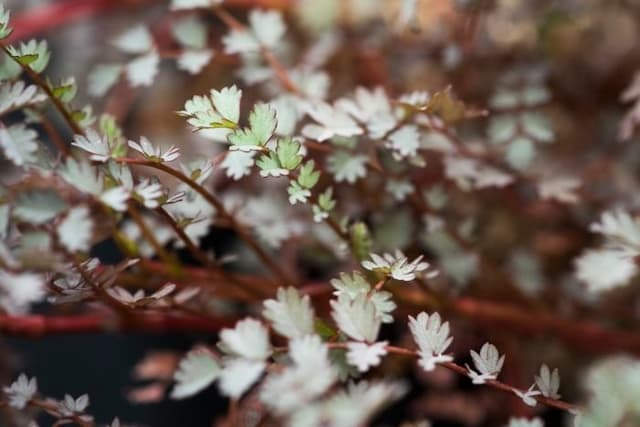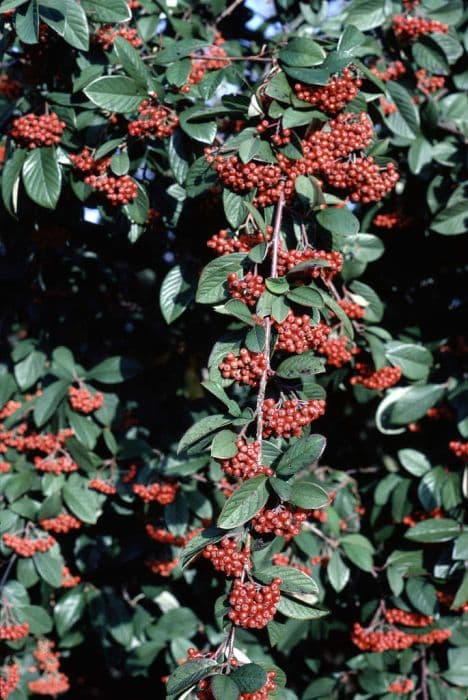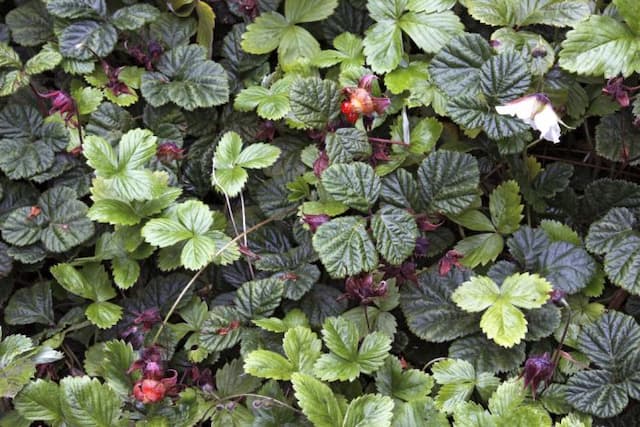Midland Hawthorn Crataegus laevigata

ABOUT
Crataegus laevigata, commonly known as midland hawthorn, is a deciduous shrub or small tree that is known for its attractive appearance, particularly during blooming season. The plant bears leaves that are typically lobed and serrated along the edges, providing a somewhat rugged texture. The foliage emerges as a fresh, bright green in spring and often transitions to shades of yellow or red before falling in the autumn. One of the most notable features of midland hawthorn is its flowers, which are typically white or sometimes pink with hints of red. These blooms are quite small individually, but they are produced in clusters that create a very showy and fragrant display in late spring to early summer. Following the flowering period, the plant produces small red fruits, often referred to as haws. These berry-like pomes are generally oval and can add further visual interest to the plant in late summer and autumn. The bark of midland hawthorn is another distinctive trait, featuring a color that ranges from gray to brown with a rough texture that can become fissured with age. The plant's branches grow in a dense and spreading fashion, sometimes with thorns, which adds to its dense, rounded overall form. In landscaping, midland hawthorn is appreciated for these ornamental qualities, as well as its hardiness and ability to provide habitat for wildlife.
About this plant
 Names
NamesFamily
Rosaceae
Synonyms
English Hawthorn, Woodland Hawthorn, Mayblossom, Maythorn, Midland Hawthorn, Smooth Hawthorn
Common names
Crataegus oxyacantha, Crataegus oxyacanthoides, Crataegus laevigata var. pallida, Mespilus laevigata.
 Toxicity
ToxicityTo humans
Hawthorn (Crataegus laevigata) has been used historically for medicinal purposes and is generally considered safe for human consumption when used correctly. Ingesting hawthorn berries, leaves, or flowers in moderate amounts is unlikely to be toxic. However, consuming large quantities could potentially lead to stomach upset, nausea, and other digestive disturbances. Additionally, the seeds inside the berries contain amygdalin, which can release cyanide when metabolized. Therefore, it is recommended to avoid consuming the seeds. If ingested in large amounts, cyanide can lead to symptoms such as difficulty breathing, weakness, and confusion, which may be severe and potentially life-threatening.
To pets
Hawthorn (Crataegus laevigata) is not commonly known to be toxic to pets. However, as with humans, the seeds found in the berries contain amygdalin and can produce cyanide when digested in large quantities. While the likelihood of pets consuming enough seeds to cause cyanide poisoning is low, symptoms of cyanide toxicity in pets include vomiting, difficulty breathing, and potentially more severe signs such as seizures or coma, which can be life-threatening. To keep pets safe, it is best to prevent them from ingesting large amounts of the berries or seeds.
 Characteristics
CharacteristicsLife cycle
Perennials
Foliage type
Deciduous
Color of leaves
Green
Flower color
White
Height
15 feet (4.57 meters)
Spread
15 feet (4.57 meters)
Plant type
Tree
Hardiness zones
5
Native area
Europe
Benefits
 General Benefits
General Benefits- Landscape Aesthetics: Crataegus laevigata, commonly known as the English hawthorn, offers seasonal beauty with its white or pink flowers in spring and deep red berries in autumn.
- Habitat for Wildlife: The English hawthorn provides shelter and food for various birds and insects, with its dense branches and fruits.
- Drought Tolerance: Once established, it has a good tolerance for drought, making it suitable for gardens in drier climates.
- Cold Hardy: It can withstand low temperatures, making it a resilient choice for northern climates.
- Urban Tolerant: The English hawthorn can survive in urban environments, tolerating pollution and compacted soil.
- Privacy and Security: It can be used as a hedge or barrier due to its thorny branches, providing privacy and deterring unwanted access.
- Ornamental Fruit: The berries can be used for decorative purposes, providing a splash of colour in floral arrangements and crafts.
- Fall Color: The leaves turn a bright range of colours in the fall, adding seasonal interest to the landscape.
 Medical Properties
Medical Properties- Cardiotonic: Hawthorn (Crataegus laevigata) has been traditionally used to support cardiac function.
- Antioxidant: Contains antioxidants that help protect cells from damage caused by free radicals.
- Anti-inflammatory: Its components are believed to offer anti-inflammatory benefits.
- Angioprotective: May help protect and support the integrity of blood vessels.
- Anxiolytic: Sometimes used in herbal medicine with a potential effect on reducing anxiety.
- Hypotensive: Contains substances that might contribute to lowering blood pressure.
- Lipid-lowering: May have a role in managing cholesterol levels though evidence is not definitive.
 Air-purifying Qualities
Air-purifying QualitiesThis plant is not specifically known for air purifying qualities.
 Other Uses
Other Uses- Crataegus laevigata, commonly known as hawthorn, can be used as a natural fabric dye, providing various shades of yellow, green, or brown depending on the mordant used.
- The wood of hawthorn is hard and dense, making it suitable for crafting small objects such as handles, tool parts, or carved figurines.
- Due to its dense and thorny nature, hawthorn can be effectively used as a living barrier or hedge, deterring trespassers and providing privacy.
- Hawthorn trees can be grown for ornamental purposes due to their attractive white or pink flowers and bright red berries, enhancing the aesthetic of gardens and landscapes.
- The bright red berries, also known as haws, are sometimes used in floral arrangements and wreaths, particularly in autumn and winter decorations.
- With proper shaping and pruning, hawthorn trees can be cultivated as bonsai, offering a challenging and rewarding experience for enthusiasts.
- The plant's dense branching habit makes it suitable for use as a windbreak or to provide shelter for wildlife in a garden or agricultural setting.
- In rural folklore, hawthorn is often planted as a protective charm near homes or on farmsteads, believed to ward off evil spirits.
- Hawthorn's blossoms and leaves can be used in the production of natural potpourris, imparting a subtle floral scent to indoor environments.
- The rigid, sharp thorns of hawthorn have historically been used as makeshift needles or for crafting fish hooks in survival situations.
Interesting Facts
 Feng Shui
Feng ShuiThe Hawthorn is not used in Feng Shui practice.
 Zodiac Sign Compitability
Zodiac Sign CompitabilityThe Hawthorn is not used in astrology practice.
 Plant Symbolism
Plant Symbolism- Hope: Crataegus laevigata, commonly known as Hawthorn, is often associated with hope due to its resilience and its ability to blossom even under difficult conditions.
- Love and Marriage: In some cultures, Hawthorn flowers are seen as symbols of love and are used in wedding ceremonies and decorations, representing happiness and longevity in relationships.
- Protection: Hawthorn trees have been thought to have protective qualities, and were often planted near homes to guard against lightning and evil spirits.
- Spring and Renewal: The blossoming of Hawthorn's white flowers signals the arrival of spring and thus symbolizes new beginnings and rejuvenation.
- Heart Health: Historically, the Hawthorn plant has been linked to heart health, not only metaphorically as a symbol of emotional well-being but also in herbal medicine for its cardiovascular benefits.
 Water
WaterFor the Midland Hawthorn, it's essential to maintain moist soil, especially during the plant's young life stage and in dry conditions. Water the plant deeply once a week, providing about 1 to 1.5 gallons per session for young plants. Mature Midland Hawthorns are drought tolerant and will require less frequent watering, perhaps every two weeks if there hasn't been substantial rain. During the growing season, you may need to water more frequently, while in winter, you can reduce watering as the plant's growth slows down. Always check the soil moisture before watering to prevent overwatering.
 Light
LightThe Midland Hawthorn thrives best in full sun to partial shade. It should be planted in a spot where it can receive at least six hours of direct sunlight per day. However, it can tolerate some light shade, especially during the hottest parts of the day. An ideal spot would be one that is sheltered from strong winds but still receives ample sunlight.
 Temperature
TemperatureThe Midland Hawthorn is a hardy plant and can tolerate a wide range of temperatures. It can survive in temperatures as low as -20 degrees Fahrenheit and as high as 100 degrees Fahrenheit. The ideal temperature range for the Midland Hawthorn is between 60 and 80 degrees Fahrenheit, which promotes healthy growth and flowering.
 Pruning
PruningPruning the Midland Hawthorn is important to maintain its shape, remove dead or diseased branches, and encourage more vigorous growth and flowering. The best time to prune is in late winter or early spring before the new growth starts. Prune back up to one-third of the oldest branches to stimulate new growth, and also remove any crossing or rubbing branches to prevent damage. Regular pruning, done annually, ensures that the Midland Hawthorn remains healthy and attractive.
 Cleaning
CleaningAs needed
 Soil
SoilMidland Hawthorn thrives in well-draining, loamy soil with a pH ranging from slightly acidic to neutral (pH 6.0-7.0). A mix of garden soil, compost, and coarse sand is ideal to ensure proper drainage and fertility.
 Repotting
RepottingMidland Hawthorn trees, being robust and often used in landscaping, generally do not require repotting as they are typically planted directly in the ground. In the context of container planting, young trees should be repotted every 2-3 years.
 Humidity & Misting
Humidity & MistingMidland Hawthorn prefers outdoor conditions, where it can tolerate a broad range of humidity levels. It is not particularly sensitive to the humidity variations typical of temperate climates.
 Suitable locations
Suitable locationsIndoor
Grow Midland Hawthorn indoors with bright light and cool temps.
Outdoor
Plant Midland Hawthorn in full sun to partial shade, in well-drained soil.
Hardiness zone
4-8 USDA
 Life cycle
Life cycleEnglish Hawthorn (Crataegus laevigata) begins its life cycle when a seed germinates, typically after a period of cold stratification, mimicking the natural cold season. The seedling emerges, developing a root system and a shoot that grows into a sapling. As the sapling matures, it develops thorny branches, saw-toothed leaves, and undergoes vegetative growth until it reaches reproductive maturity. Once mature, usually after several years, the hawthorn produces clusters of white or pink flowers in late spring, which are pollinated by insects. Following pollination, the flowers develop into small red pome fruits, each containing one to five seeds, which are then dispersed by birds and mammals. The plant continues this cycle annually, with older hawthorns capable of living for many decades and reaching heights of up to 20 feet or more.
 Propogation
PropogationPropogation time
Spring to Early Summer
The most popular method for propagating the common hawthorn (Crataegus laevigata) is by seed. It is best to collect haws, which are the fruit of the hawthorn, in the fall after they have ripened. Once collected, they require a period of cold stratification to break the seed dormancy. This is typically achieved by mixing the seeds with moist sand and storing them in a refrigerator at about 34 to 40 degrees Fahrenheit (1 to 4 degrees Celsius) for approximately 3-4 months. After stratification, the seeds are sown in the spring in a well-draining soil mix, usually at a depth of about 1/4 inch (0.6 centimeters). They require consistent moisture and can take from a few months to a year to germinate. Seedlings tend to grow relatively slowly and may need a few years of growth before they are ready for transplantation to their permanent locations.





![Indian hawthorn [Enchantress]](/_next/image?url=https%3A%2F%2Fplants-admin.emdemapps.com%2Fimages%2Fplants%2F%2Fimages%2F604b5eefbd4f1.png&w=640&q=75)



